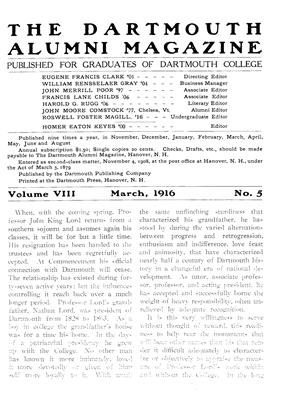The Thayer Society of Engineers of Dartmouth College had a noteworthy annual meeting and dinner in New York City on January 18, in the rooms of the Aldine Club, Fifth Avenue Building, 5th Avenue and 23d Street. Thayer School men to the number of forty-six were present and invited guests, making a total of fifty-four.
The principal guests and speakers were Dr. C. R. Mann, of the Carnegie Foundation for Advancement of Teaching; Henry W. Hodge, Civil Engineer, recently appointed by Mayor Mitchel to be Chief of the Public Service Comnission of New York, and Henry B. Thayer (D. C., 1879), President of the Western Electric Company, the newly elected Trustee of the College. The Board of Overseers of the Thayer School was represented by J. P. Snow, Civil Engineer, of Boston (T. S., 1875),' lately Chief Engineer of the Boston & Maine Railway, and by O. E. Hovey, Assistant Chief Engineer of the American Bridge Company. The Thayer School Faculty was represented by Professors Fletcher, Hazen, and Holden Charles A. Rich (D. C., 1875), Architect of new Dartmouth buildings, etc., was also present.
Dr. Mann gave an interesting resume of the results of the sending out of the questionnaire on engineering education to about 8000 members of the four leading engineering societies of the United States, last summer. Only about 1500 replies were received and many of these failed to meet the intent of the inquiry. The investigators had proceeded far enough to squarely raise the question, "What is an engineer?" They propose to put this question to the engineers by another questionnaire to be sent out in the near future. When the engineer has been fully described and defined by the engineers themselves, the inquirers will hold this model up before the engineering schools and say: "This is the sort of thing you are expected to produce." The Carnegie Foundation has thus taken over the investigation originally begun by Committees of the American Society of Civil Engineers and the Society for Promotion of Engineering Education, who found the question to be so large that they requested the aid of the Carnegie Foundation.
Commissioner Hodge gave a very forceful address urging upon the engineers to live and labor with the spirit and purpose of strenuous service; subordinating the idea of mere gain or commercialism to that of Smeaton's maxim, that the abilities of the individual are a debt due to .the common stock of the public well-being. He pointed out -some ways in which they might serve their home community,—as a labor of love, and so develop character and ability fitting them for larger service to the State and Nation.
Mr. Thayer acknowledged a distant relationship to the founder of the Thayer School, gave a brief sketch of the life and work of General Thayer, and laid emphasis on his high ideal and strict standard of attainment which at the time were so much in advance of institutions elsewhere, but which are now generally recognized as necessary and proper.
Letters of regret at inability to be present, and sending cordial greetings, were read from President-emeritus William J. Tucker and other members of the Society.
Mr. Snow spoke for the Board of Overseers, and Professors Fletcher, Hazen and Holden for the Faculty.
Mr. E. J. Morrison (T. S. C. E., 1893) President and Engineer of the Hastings Pavement Company of New York, President of the Society, presided and acted as toastmaster. The Secretary's report was read by Mr. George C. Stoddard, Dartmouth College, 1881, and the treasurer's report by F. E. Cudworth, T. S. C. E., 1902. They announced that the Society, besides meeting the cost of publication of the Annual of 1915, had given $1000 as the nucleus of an endowment fund to bear the name of the Thayer Society of Engineers, the income of which is to be applied, at the discretion of the Board of Overseers, for general purposes. In addition to this a check for $500 was sent to the Treasurer of the College to reinforce the income and be applied to meeting the expenses of the current year.
Mr. Morrison has since presented to the Thayer School a large and excellent photograph of the gathering, taken as all were seated at the tables; in this the likenesses are unusually good for a picture taken under such conditions.
 View Full Issue
View Full Issue
More From This Issue
-
 Article
ArticleALONG THE OUTING CLUB TRAIL ON SKIS
March 1916 By Fred H. Harris '11 -
 Article
ArticleSOME LETTERS OF NATHAN SMITH
March 1916 -
 Article
ArticleTHE FEBRUARY MEETING OF THE TRUSTEES
March 1916 -
 Article
ArticleEXHIBITION OF CORNISH ARTISTS
March 1916 By George Breed Zug -
 Class Notes
Class NotesLOCAL ASSOCIATIONS
March 1916 -
 Article
ArticleWhen, with the coming spring, Professor John King Lord returns
March 1916
Article
-
 Article
ArticleMasthead
May 1925 -
 Article
ArticleSoccer
December 1957 -
 Article
ArticleRussian Institute
June 1960 -
 Article
ArticleREPORT OF THE COMMITTEE ON SCHOOLS
AUGUST 1930 By G. C. RICHARDS '96 -
 Article
ArticleTuck School
January 1961 By GKORGE P. DROWNE JR. '33 -
 Article
ArticleThe Loves: Dartmouth's Corporate Couple
APRIL • 1987 By Rex Roberts



